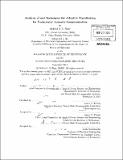Analysis of and techniques for adaptive equalization for underwater acoustic communication
Author(s)
Blair, Ballard J. S. (Ballard Justin Smith)
DownloadFull printable version (17.25Mb)
Other Contributors
Woods Hole Oceanographic Institution.
Advisor
James C. Preisig.
Terms of use
Metadata
Show full item recordAbstract
Underwater wireless communication is quickly becoming a necessity for applications in ocean science, defense, and homeland security. Acoustics remains the only practical means of accomplishing long-range communication in the ocean. The acoustic communication channel is fraught with difficulties including limited available bandwidth, long delay-spread, time-variability, and Doppler spreading. These difficulties reduce the reliability of the communication system and make high data-rate communication challenging. Adaptive decision feedback equalization is a common method to compensate for distortions introduced by the underwater acoustic channel. Limited work has been done thus far to introduce the physics of the underwater channel into improving and better understanding the operation of a decision feedback equalizer. This thesis examines how to use physical models to improve the reliability and reduce the computational complexity of the decision feedback equalizer. The specific topics covered by this work are: how to handle channel estimation errors for the time varying channel, how to use angular constraints imposed by the environment into an array receiver, what happens when there is a mismatch between the true channel order and the estimated channel order, and why there is a performance difference between the direct adaptation and channel estimation based methods for computing the equalizer coefficients. For each of these topics, algorithms are provided that help create a more robust equalizer with lower computational complexity for the underwater channel.
Description
Thesis (Ph. D.)--Joint Program in Oceanography/Applied Ocean Science and Engineering (Massachusetts Institute of Technology, Dept. of Electrical Engineering and Computer Science; and the Woods Hole Oceanographic Institution), 2011. Cataloged from PDF version of thesis. Includes bibliographical references (p. 203-215).
Date issued
2011Department
Joint Program in Oceanography/Applied Ocean Science and Engineering; Woods Hole Oceanographic Institution; Massachusetts Institute of Technology. Department of Electrical Engineering and Computer SciencePublisher
Massachusetts Institute of Technology
Keywords
Joint Program in Oceanography/Applied Ocean Science and Engineering., Electrical Engineering and Computer Science., Woods Hole Oceanographic Institution.